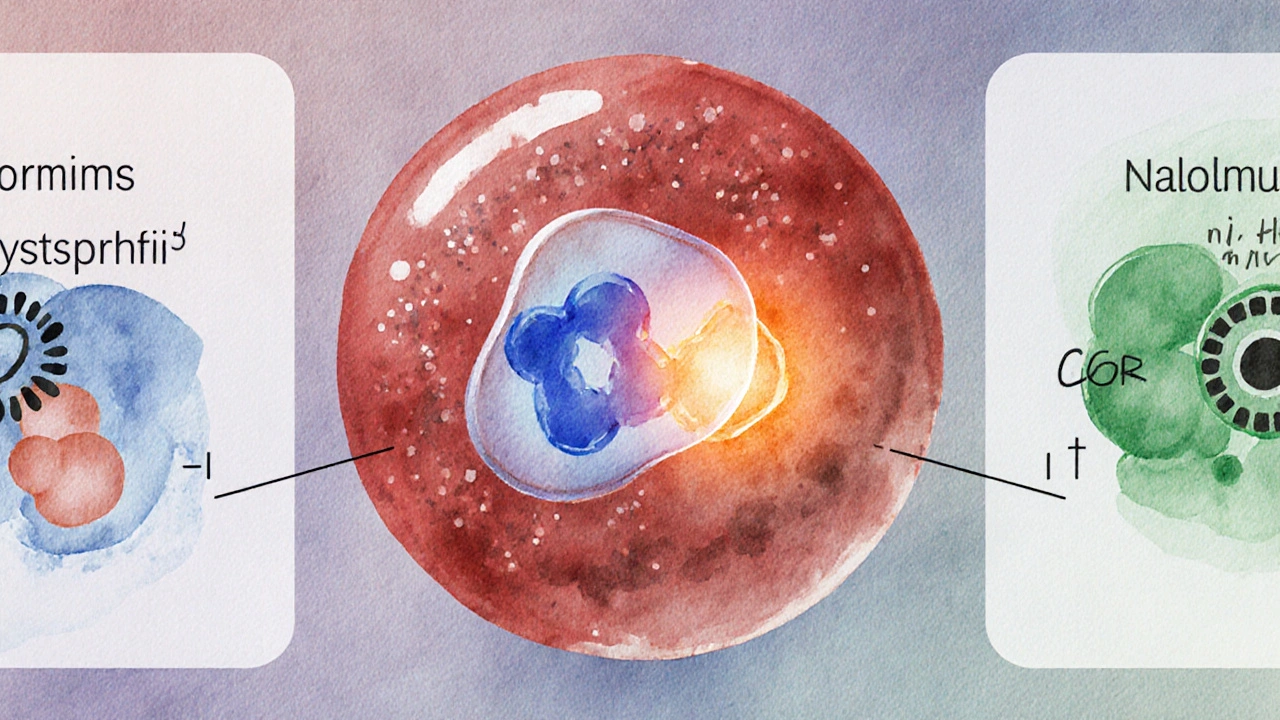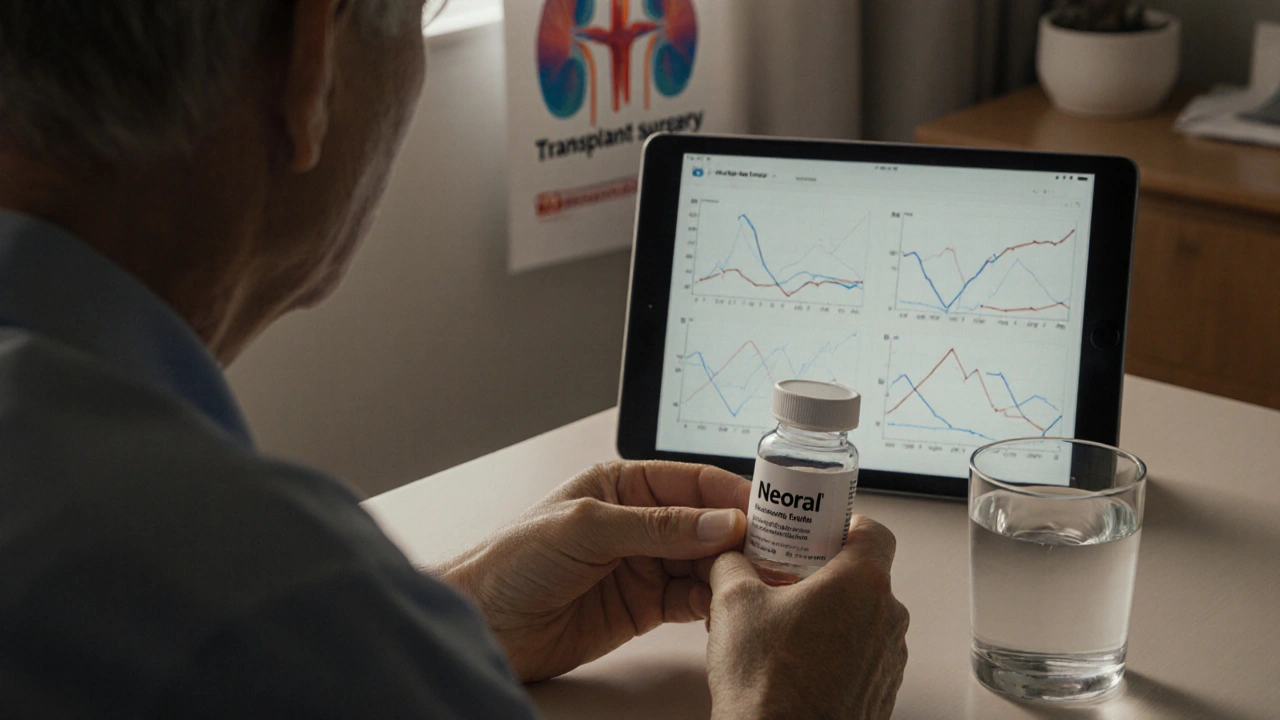Immunosuppressant Comparison Tool
Choose Your Top Priorities
Select the factors most important for your situation
Your Kidney Function
Quick Takeaways
- Neoral is the branded form of cyclosporine, a calcineurin inhibitor used to prevent organ rejection.
- Generic cyclosporine provides the same potency at a lower price, though absorption can vary.
- Tacrolimus delivers similar immune suppression but often with fewer gum issues and different kidney‑related side effects.
- Sirolimus and everolimus target the mTOR pathway, making them good options when calcineurin inhibitors cause nephrotoxicity.
- Mycophenolate mofetil and azathioprine are antiproliferative agents that can be combined with lower doses of calcineurin inhibitors for added safety.
What is Neoral?
When talking about transplant drugs, Neoral is the brand name for cyclosporine, a calcineurin inhibitor that dampens the immune response to protect a new organ from rejection. First approved by the FDA in 1983, Neoral uses a microemulsion formulation that improves bioavailability compared with the older Sandimmune version. Typical dosing after a kidney transplant starts around 5mg/kg per day, split into two doses, and is adjusted based on blood levels (the trough level).
How Does Cyclosporine Work?
Cyclosporine binds to the intracellular protein cyclophilin, forming a complex that blocks the activation of calcineurin. Calcineurin is essential for turning on interleukin‑2, a signal that tells T‑cells to multiply. By cutting this signal, cyclosporine reduces the number of active T‑cells, which lowers the chance that the immune system attacks the transplanted organ.
Because the drug affects the whole immune system, side effects can include kidney‑function decline, high blood pressure, gum overgrowth, tremor, and increased cholesterol. Monitoring blood levels and kidney labs is a routine part of any cyclosporine‑based regimen.

Alternatives Overview
Several other immunosuppressants can replace or supplement Neoral. Below are the most common options, each introduced with brief microdata for easy knowledge‑graph integration.
Tacrolimus is a calcineurin inhibitor like cyclosporine, but it binds to the protein FKBP‑12 instead of cyclophilin, offering a slightly different side‑effect profile. FDA‑approved in 1994, it’s often the first‑line choice for kidney and liver transplants.
Sirolimus (also called rapamycin) blocks the mammalian target of rapamycin (mTOR) pathway, preventing T‑cell proliferation downstream of interleukin‑2. It was approved in 1999 and works well when calcineurin inhibitors cause nephrotoxicity.
Everolimus is a newer mTOR inhibitor, chemically similar to sirolimus but with a shorter half‑life, allowing more flexible dosing. FDA approval came in 2010 for kidney‑transplant maintenance.
Mycophenolate mofetil (MMF) inhibits inosine monophosphate dehydrogenase, curbing the proliferation of both B‑ and T‑cells. Introduced in 1995, it’s commonly paired with a reduced‑dose calcineurin inhibitor.
Azathioprine is an antimetabolite that interferes with DNA synthesis in rapidly dividing cells, including lymphocytes. It dates back to the 1960s and is used when patients can’t tolerate newer agents.
Belatacept is a selective costimulation blocker that prevents T‑cell activation by binding CD80/86. Approved in 2011, it’s an option for patients with severe calcineurin‑inhibitor nephrotoxicity.
Prednisone (a corticosteroid) is often used in the early post‑transplant period for rapid inflammation control, but long‑term use is minimized due to bone‑loss and metabolic risks.
Side‑by‑Side Comparison
| Drug | Mechanism | Typical Dose | Major Side Effects | Average Monthly Cost (US$) |
|---|---|---|---|---|
| Neoral (cyclosporine) | Calcineurin inhibition via cyclophilin binding | 5mg/kg/day split BID, adjusted to trough 100‑200ng/mL | Nephrotoxicity, hypertension, gum hyperplasia, hyperlipidemia | ≈$300‑$500 (brand); generic $150‑$250 |
| Tacrolimus | Calcineurin inhibition via FKBP‑12 binding | 0.1mg/kg BID, trough 5‑15ng/mL | Nephrotoxicity, neurotoxicity (tremor, seizures), diabetes | ≈$400‑$600 |
| Sirolimus | mTOR inhibition | 2mg daily, trough 5‑15ng/mL | Hyperlipidemia, delayed wound healing, anemia | ≈$350‑$550 |
| Everolimus | mTOR inhibition (shorter half‑life) | 0.75mg BID, trough 3‑8ng/mL | Stomatitis, hyperlipidemia, proteinuria | ≈$380‑$600 |
| Mycophenolate mofetil | Inosine monophosphate dehydrogenase inhibition | 1g BID | Gastrointestinal upset, leukopenia, infection risk | ≈$200‑$350 |
| Azathioprine | Purine synthesis inhibition | 1‑2mg/kg/day | Liver toxicity, bone‑marrow suppression, pancreatitis | ≈$100‑$150 |
| Belatacept | Costimulation blockade (CD80/86) | 10mg on day0, 14, 28 then 5mg Q‑month | Post‑infusion reactions, PTLD (rare), infection | ≈$1,200‑$1,800 (IV) |
How to Choose the Right Option
Picking a replacement for Neoral isn’t just about price. Consider these three decision pillars:
- Kidney safety: If you have pre‑existing renal impairment, mTOR inhibitors (sirolimus, everolimus) or low‑dose tacrolimus may spare the kidneys better than full‑strength cyclosporine.
- Side‑effect tolerance: Some patients can’t handle gum overgrowth or high cholesterol, steering them toward tacrolimus or MMF. Others worry about diabetes risk, making azathioprine a safer bet.
- Convenience & monitoring: Neoral and tacrolimus require frequent blood‑level checks. Belatacept needs monthly infusions but eliminates daily pills. Your lifestyle and access to a transplant clinic matter.
Talk with your transplant pharmacist; they can run a cost‑analysis based on your insurance and suggest therapeutic‑drug‑monitoring schedules.

Practical Tips & Common Pitfalls
- Never switch from Neoral to another calcineurin inhibitor without a taper plan - abrupt changes can trigger acute rejection.
- When using generic cyclosporine, verify that the pharmacy follows bioequivalence testing; a 10‑15% variance in blood levels is possible.
- Combine mTOR inhibitors with reduced‑dose tacrolimus only under close lab surveillance; the combo can amplify lipid abnormalities.
- Always take these meds with a consistent amount of food; high‑fat meals increase cyclosporine absorption, leading to higher troughs.
- Keep a medication diary, noting any new symptoms (e.g., tremor, mouth sores). Early reporting helps adjust doses before serious damage occurs.
Frequently Asked Questions
Can I replace Neoral with generic cyclosporine?
Yes, many patients switch to generic cyclosporine to cut costs. The active ingredient is identical, but you may notice slightly different blood‑level spikes. Your transplant team should re‑check trough levels after the switch and adjust the dose if needed.
Is tacrolimus safer for the kidneys than Neoral?
Tacrolimus is generally considered less nephrotoxic at therapeutic levels, though both drugs can still affect kidney function. For patients with borderline renal function, many clinicians start with low‑dose tacrolimus and monitor creatinine closely.
What are the main reasons to choose an mTOR inhibitor over a calcineurin inhibitor?
mTOR inhibitors avoid the classic calcineurin‑related nephrotoxicity and hypertension. They’re useful when a patient develops severe side effects from cyclosporine or tacrolimus, or when you want to lower overall immunosuppression by combining lower doses of both classes.
How often should I get blood‑level tests for Neoral or its alternatives?
During the first 3months after transplant, weekly troughs are standard for both Neoral and tacrolimus. Once stable, labs are usually spaced to every 2‑4weeks, then every 3‑6months. mTOR inhibitors often require the same frequency, while MMF and azathioprine rely more on CBC monitoring than drug levels.
Are there any food or drug interactions I should watch for?
Yes. Grapefruit juice can raise cyclosporine and tacrolimus levels. High‑fat meals increase cyclosporine absorption. Certain antibiotics (e.g., erythromycin, clarithromycin) and antifungals (ketoconazole) also boost calcineurin‑inhibitor concentrations. Always tell your doctor about over‑the‑counter meds and supplements.
What should I do if I miss a dose?
Take the missed dose as soon as you remember, unless it’s almost time for the next dose. In that case, skip the missed one and resume the regular schedule. Never double up, because too‑high trough levels raise rejection risk and toxicity.
Next Steps
If you’re weighing Neoral alternatives, start by listing your top priorities-cost, kidney safety, or side‑effect profile. Bring that list to your transplant physician or pharmacist, ask for a blood‑level plan, and confirm insurance coverage for the chosen drug. Finally, keep a log of any new symptoms and schedule your labs on time; staying proactive is the best way to protect your new organ.





Naresh Sehgal
October 13, 2025 AT 20:25If you're staring at that massive comparison table, remember that each drug has a unique risk‑benefit profile. Neoral, as the original cyclosporine formulation, still packs a punch for many transplant protocols, but you can’t ignore the nephrotoxic potential. Keep your trough levels tight, and don’t forget to pair the medication with a low‑sodium diet to protect your kidneys. Also, watch out for gum overgrowth-regular dental cleanings can keep that from becoming a nightmare. Finally, if cost is a concern, ask your pharmacist about a generic version; the bioequivalence is proven and the savings are real.
Poppy Johnston
October 23, 2025 AT 16:32Great summary-helps cut through the jargon.
Johnny VonGriz
November 2, 2025 AT 12:39I’ve been on a tacrolimus‑based regimen for three years, and I can confirm that the kidney‑sparing profile is noticeable compared with my earlier cyclosporine experience. The blood‑level monitoring schedule is similar, but I’ve seen fewer spikes in my creatinine. Combining tacrolimus with a low dose of mycophenolate mofetil gave me a smoother immune suppression curve, which reduced the number of biopsy‑proven rejections. One thing to keep in mind is the higher risk of new‑onset diabetes; a diet low in simple carbs really helped. Side‑effects like tremor were rare for me, but they can be a deal‑breaker for some patients. If you’re concerned about cost, many insurance plans treat tacrolimus as a tier‑2 drug, so check your formulary. Also, remember that grapefruit juice can push tacrolimus levels up dramatically-avoid it unless you want a surprise dose adjustment. Overall, the switch felt worth it for my kidney health and quality of life.
Real Strategy PR
November 12, 2025 AT 08:45Skipping a proper taper when moving off Neoral is simply reckless; you jeopardize graft survival. Follow a clinician‑directed protocol or face the consequences.
Doug Clayton
November 22, 2025 AT 04:52Neoral can work if you stay on schedule and get your labs done regularly. The drug level checks are essential you don’t want surprise rejections. Keep your diet consistent especially with fat intake. Talk to your pharmacist about generic options they can save you money.
Michelle Zhao
December 2, 2025 AT 00:59In the grand theatre of transplant pharmacology, Neoral assumes the role of the venerable protagonist, steadfast yet burdened by an entourage of adverse effects. Its calcineurin‑inhibiting mechanism, while undeniably efficacious, bears the stigma of nephrotoxicity, a shadow that looms over any organ recipient. Conversely, tacrolimus emerges as a compelling antagonist, offering comparable immunosuppression with a distinct side‑effect script, notably a propensity for neurotoxicity and dysglycemia. The mTOR inhibitors-sirolimus and everolimus-enter the stage as the avant‑garde, promising renal preservation at the expense of delayed wound healing and hyperlipidaemia. Mycophenolate mofetil and azathioprine, though less glamorous, provide invaluable supporting roles, enabling dosage reductions of the principal agents. Belatacept, the newcomer, writes its own narrative, eschewing daily pills for monthly infusions, yet demanding vigilance for post‑transplant lymphoproliferative disorder. Ultimately, the selection of a regimen must be choreographed to the patient’s comorbidities, financial realities, and personal preferences, lest the performance falter.
Mary Magdalen
December 11, 2025 AT 21:05Let’s be clear: the United States leads the world in transplant research, and its drug pipelines have produced the most robust immunosuppressants. While European “generic” cyclosporine may claim cost savings, the quality control often falls short of our exacting standards. Trusting foreign‑made Neoral equivalents when you have access to domestically vetted formulations is a gamble you shouldn’t take. The pharmacokinetic profile of American‑produced tacrolimus reflects rigorous FDA oversight, translating into more predictable troughs and fewer surprises. Moreover, the industrial might behind our mTOR inhibitors fuels innovation that overseas competitors can only mimic. If you value your graft, stick with the home‑grown options that have passed the toughest safety nets.